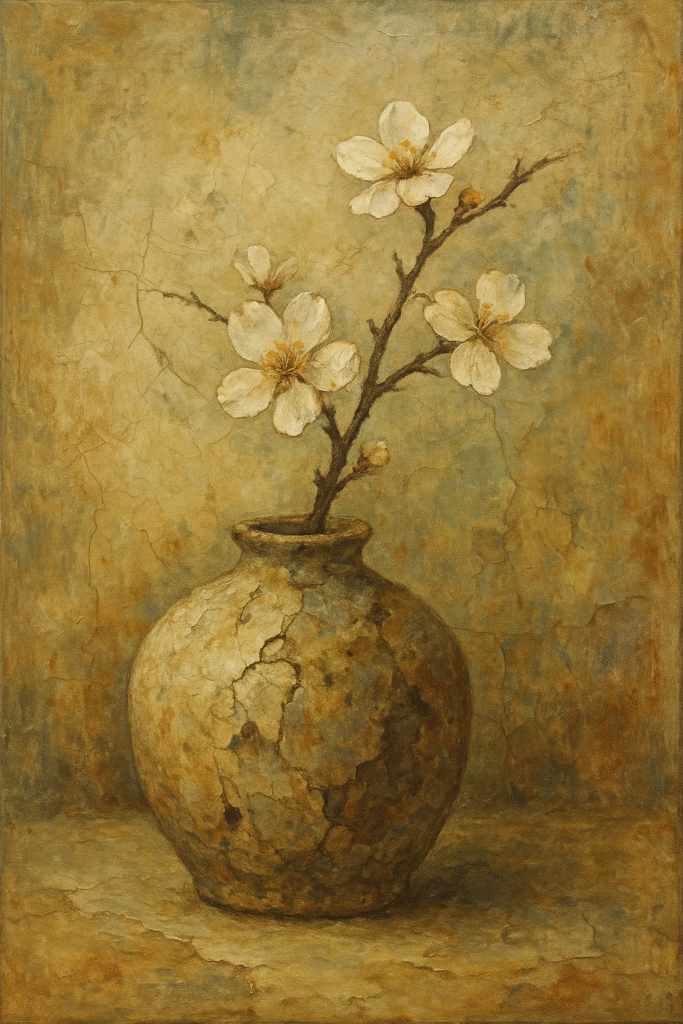Introduction to Wabi-Sabi and Its Origins
Wabi-Sabi is a profound Japanese aesthetic philosophy that evokes a sense of beauty found in the imperfect, the impermanent, and the incomplete. Its origins can be traced back to Zen Buddhism and the traditional Japanese tea ceremony, where simplicity and tranquility are paramount. However, its roots stretch deeper into Japanese culture, reflecting a worldview that resonates with the natural cycles of life.
The term ‘Wabi’ denotes rustic simplicity, tranquility, and naturalness, while ‘Sabi’ refers to beauty that emerges from age, wear, and the passage of time. Together, Wabi-Sabi encourages a deep appreciation for the fleeting moments of beauty in our lives, offering a compelling counter-narrative to society’s obsession with perfection and flawlessness.
Historically, during the 15th century, Wabi-Sabi began to flourish within the context of the aesthetics of the tea ceremony influenced by Zen Buddhism. The tea master’s tacit acknowledgment of the beauty in the imperfect bamboo tools, uneven hand-crafted ceramics, or natural landscape settings set the stage for this philosophy to permeate Japanese art and culture.
In today’s increasingly fast-paced and perfection-driven society, Wabi-Sabi presents an opportunity for deeper mindfulness and acceptance of our intrinsic imperfections. By recognizing the beauty in flaws, we can cultivate a more fulfilled existence grounded in authenticity and appreciation.
Core Principles of Wabi-Sabi and How to Apply Them
Understanding Wabi-Sabi involves delving into its core principles, which provide guidance on how to incorporate this philosophy into various aspects of life. Here are the fundamental tenets of Wabi-Sabi:
1. Embrace Imperfection
One of the most significant teachings of Wabi-Sabi is the acceptance of imperfection. Instead of striving for unattainable ideals, the philosophy encourages individuals to celebrate flaws and shortfalls. From the cracked vase to a worn-out painting, every imperfection narrates a story of life—time, history, and character. Adopting this perspective invites deeper appreciation for our surroundings and experiences, reminding us that mistakes and imperfections are intrinsic to the human experience.
Application: In daily life, challenge yourself to appreciate things as they are. Rather than cleaning up or altering minor imperfections, embrace them. The next time you see a scratch on your favorite piece of furniture or a stain on your clothing, notice what those marks signify—memories, moments, and personal history.
2. Celebrate Transience
Wabi-Sabi acknowledges that life is ephemeral, and everything is subject to change. The cycle of birth, growth, decay, and death is a natural part of existence. Celebrating this transience generates a deep appreciation for moments fleeting, urging a mindfulness that enriches everyday life.
Application: Engage in practices that foster awareness of the present moment, such as mindfulness meditation or nature walks, to observe the beauty in changing seasons and cycles of nature. Creating rituals around seasonal events or acknowledging milestones can also provide focus: moments of loss, change, and renewal remind us of life’s tender ephemerality.
3. Value Simplicity
Simplicity is at the heart of Wabi-Sabi. It encourages a simplified environment that eliminates clutter, both physically and mentally. The philosophy offers a way to curate our lives and surroundings through intentional choice, fostering peace, and clarity.
Application: Undertake decluttering tasks—remove excess possessions that don’t hold sentimental value or practicality. Instead, curate your environment with meaningful, handcrafted items that resonate with you. You can also simplify your daily schedule by prioritizing activities that genuinely reflect your desires and values.
4. Find Beauty in Nature
Nature exemplifies Wabi-Sabi principles—the rough textures of weathered wood, the flaws in a stone, or the unique shape of a leaf are reflective of a natural beauty that embodies imperfection.
Application: Engage with nature by cultivating a plant, exploring a park, or simply observing changes in your surroundings over time. Natural elements often provoke grounding moments that remind us of our connection to the world around us.
5. Create with Intention
The art of Wabi-Sabi encourages mindful creation. Every piece of art, whether a painting, sculpture, or piece of pottery, should reflect an honest expression of oneself that acknowledges each nuance of the process.
Application: When engaging in creative endeavors, focus on the process rather than the outcome. Allow each brushstroke, sculptural movement, or material choice to embody your emotions, thoughts, and authenticity, celebrating the imperfections that arise in the journey.
Real-Life Examples of Wabi-Sabi in Art and Everyday Life
Wabi-Sabi’s principles can be seen applied not only in the realms of art and design but also in lifestyles that promote authenticity and mindfulness. Here are several examples:
Art Examples
- Ceramics: Traditional Japanese ceramics are often considered exemplary models of Wabi-Sabi. For instance, the famous Raku pottery is characterized by irregular shapes, glazes that seem imperfect, and surfaces that reveal the firing process’s history. These ceramics inspire a sense of warmth and humanity, rather than soulless precision.
- Architecture: The architecture of old Japanese temples presents a physical manifestation of Wabi-Sabi. The rustic and the aged structures symbolize harmony with nature, emphasizing simplicity, balance, and a connection to the spiritual world. Modern architecture, too, incorporates Wabi-Sabi elements through the use of natural materials and asymmetrical designs to evoke a sense of tranquility and focus on environment.
- Paintings: One classic example is the work of Japanese artist Katsushika Hokusai, whose famous woodblock prints feature elements of natural imperfection—waves, flowers, and landscapes depicted with a sense of authenticity, that captures moments through slightly askew views and delicate imperfections.
Everyday Life
- Interior Design: Many modern interior designs embrace Wabi-Sabi philosophy by integrating vintage items that tell a story, using organic shapes and materials, or incorporating handmade elements like woven textiles that familiarized imperfections and asymmetry.
- Fashion: The slow fashion movement aligns closely with Wabi-Sabi. Brands that focus on sustainable practices often use natural fabrics that wear gracefully over time, creating garments that embody wear rather than trends. Individuals increasingly embrace ‘perfectly imperfect’ styles, opting for hand-made or vintage clothing that adds character to personal expressions.
- Mindfulness Practices: Mindfulness allows individuals to appreciate the beauty in their lives as it unfolds. Practices such as journaling, yoga, or mindful eating encourage people to slow down and acknowledge the transient nature of experiences.
Psychological Benefits of Embracing Imperfection
Embracing Wabi-Sabi and accepting imperfection isn’t just about aesthetics—it carries profound psychological advantages. Here are a few key benefits:
Reduced Anxiety and Stress
Acknowledging imperfection can significantly reduce anxiety associated with perfectionism. When individuals accept their flaws—whether in themselves or their circumstances—they cultivate a more peaceful mindset. This acceptance provides room for self-compassion and reduces the pressure to achieve unattainable standards.
Increased Resilience
Embracing imperfection fosters resilience, enabling one to navigate the ebb and flow of life’s challenges. By recognizing that setbacks and failures are natural, individuals can develop greater emotional strength and adaptive capacity. This counters the fear of taking risks, leading to personal growth and deeper life satisfaction.
Greater Authenticity
Living authentically necessitates accepting one’s flaws and vulnerabilities. Wabi-Sabi promotes self-discovery as individuals learn to accept their imperfections, allowing for richer connections with others and more genuine interactions. Authentic living encourages deeper relationships, promoting emotional intimacy.
Enhanced Mindfulness
The practice of Wabi-Sabi emphasizes mindfulness—the aware and non-judgmental observation of thoughts and feelings. Engaging with this awareness fosters concentration and presence, ultimately enhancing overall well-being. Mindfulness encourages us to appreciate small moments that often go unnoticed in the rush of daily life.
Conclusion
Wabi-Sabi serves as a philosophical foundation that invites us to pause, reflect, and appreciate the beauty found in life’s imperfections. By integrating its principles—embracing imperfection, celebrating transience, valuing simplicity, and finding beauty in nature—individuals can cultivate a more profound connection to their surroundings and themselves. As the world continues to champion an unattainable ideal of perfection, Wabi-Sabi stands as a gentle reminder to turn our gaze toward the flaws, cracks, and unfinished aspects of life, allowing us to experience its true beauty.
FAQ Section
What is Wabi-Sabi?
Wabi-Sabi is a Japanese aesthetic philosophy that celebrates beauty in imperfection and transience. It recognizes the value of simplicity and the passage of time in shaping and enhancing objects and experiences.
How can I apply Wabi-Sabi in my everyday life?
To apply Wabi-Sabi in daily life, you can embrace imperfections, simplify your surroundings, practice mindfulness, and appreciate nature. Celebrate the moments and items that hold stories and character, rather than aiming for flawless ideals.
Can Wabi-Sabi be applied outside of Japanese culture?
Absolutely! While Wabi-Sabi has its origins in Japanese culture, its principles resonate universally. Anyone can embrace a mindset that appreciates imperfection and transience, regardless of their cultural background.
What are the psychological benefits of embracing imperfection?
Embracing imperfection can reduce anxiety and stress, foster resilience, enhance authenticity, and promote mindfulness. It encourages self-acceptance and deepening connections with others by appreciating our shared vulnerabilities.
How does Wabi-Sabi influence modern design and art?
Wabi-Sabi has influenced modern design and art by promoting the use of natural materials, simplicity, and asymmetry. Artists and designers now celebrate the beauty of handmade and vintage items, often incorporating elements that tell a story and represent the passage of time.
Is Wabi-Sabi only about aesthetics?
While Wabi-Sabi encompasses aesthetic appreciation, it is also deeply philosophical. It represents a way of living that encourages mindfulness, self-acceptance, and the recognition of life’s ephemerality, ultimately leading to a more fulfilled existence.


